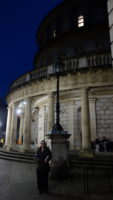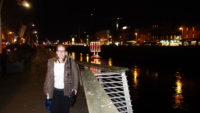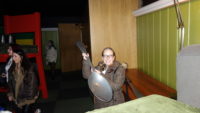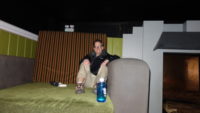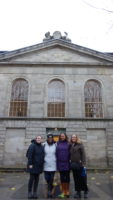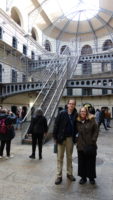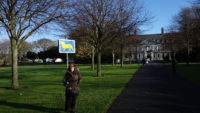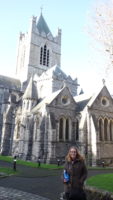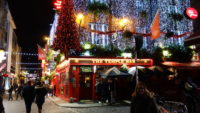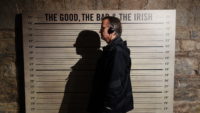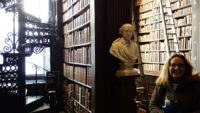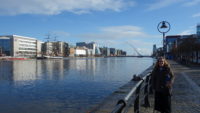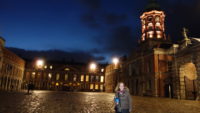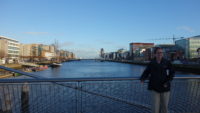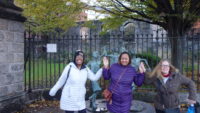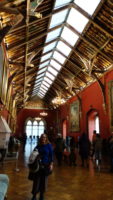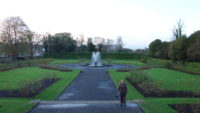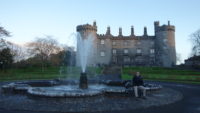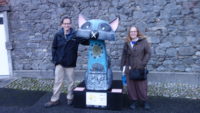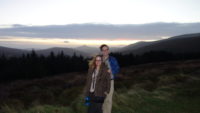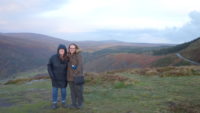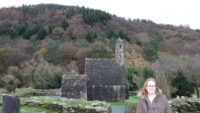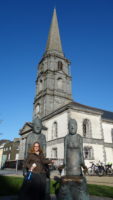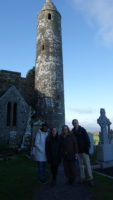 Keen observation is key to good tourism. It helps you more fully appreciate art, scenery, local culture, and more. If observation opens the lock of tourism, I misplaced the combination today. Happily, good fortune, kind people, and some gracious mercy from God kept saving me.
Keen observation is key to good tourism. It helps you more fully appreciate art, scenery, local culture, and more. If observation opens the lock of tourism, I misplaced the combination today. Happily, good fortune, kind people, and some gracious mercy from God kept saving me.
After breakfast in Waterford, we headed out to Cashel, about eighty minutes away. We had no real difficulty in getting there, although my GPS sent us down some “real” Irish back roads that were narrow, so the others got to experience the joy of one-lane two-way roads. Meredith and I were at the Rock of Cashel last March, but this time we approached it in such a way as to be able to see it as we approached, and it was an impressive sight to which to drive up.
We bought a ticket for a guided tour, since we enjoy those, and it gave us about twenty minutes before the tour let us into Cormac’s Chapel. The chapel is the first and only intact Romanesque chapel in Ireland, and access is restricted to only fifteen minutes each hour to try to help preserve the (water-absorbing) sandstone structure. Since we had time, we went to see if the audiovisual presentation was running, and it was. That was new to me and Meredith since it hadn’t been running last March, and the part we saw ran through the local area history from about 1200 and on, with a focus on ecclesiastical efforts of ordinary monks since they interacted with ordinary people. We had to leave for the tour before the film looped back around to the early period of the Rock.
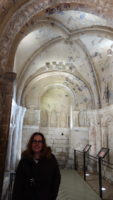 Cormac’s Chapel was fully restored over a period of seven years, with a roof being built over the structure to allow it to dry out, which took three years alone. It reopened for limited-number tours in 2017. It’s a small building, but the carvings in the rock, especially on the inside, are well preserved, and a few traces of 1100s paintings still survive inside. A larger chapel was built right next to (as in inches away from) parts of the smaller building about one hundred years later as something of a power play, as a bishop from a competing family wanted to show off his building over the older chapel.
Cormac’s Chapel was fully restored over a period of seven years, with a roof being built over the structure to allow it to dry out, which took three years alone. It reopened for limited-number tours in 2017. It’s a small building, but the carvings in the rock, especially on the inside, are well preserved, and a few traces of 1100s paintings still survive inside. A larger chapel was built right next to (as in inches away from) parts of the smaller building about one hundred years later as something of a power play, as a bishop from a competing family wanted to show off his building over the older chapel.
With the exception of the round tower (from around 1100), the rest of the buildings on the Rock are in some form of ruin – none have full, if any, roofs, and the Bishop’s Palace is closed to tours since it is so caved in. But, on the top of a wind-swept hill overlooking beautiful countryside, the ruins are picturesque. The cathedral is surrounded by a still-used graveyard, but it was closed in 1930 to all except people who signed themselves and their children up in a register. There are still five people left alive who have the option of being buried on the Rock when they pass away.
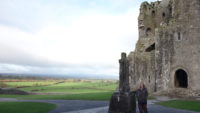 After the tour and another circuit of the grounds to take photos, we returned to the car to beeline for Dublin. It meant skipping lunch, but Dublin was about ninety minutes away, and I could get us to our hotel by about 2:30 if we didn’t stop. That would allow me to try to get the car back to the airport before rush hour. Happily, the others agreed to the plan, and so we drove to Dublin.
After the tour and another circuit of the grounds to take photos, we returned to the car to beeline for Dublin. It meant skipping lunch, but Dublin was about ninety minutes away, and I could get us to our hotel by about 2:30 if we didn’t stop. That would allow me to try to get the car back to the airport before rush hour. Happily, the others agreed to the plan, and so we drove to Dublin.
Getting into Dublin was less troublesome than I had anticipated. I dropped the others at the hotel so they could tour while I took the two-plus hours to return the car and get back to Dublin on a bus. While I was away, the others went to the National Museum of Archaeology to look at the remains of people who had been preserved in bogs and to look at treasure hoards that had been found.
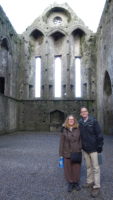 Meanwhile, I drove the leisurely way back to the airport, going right through Dublin. Some parts were very slow, with traffic backed up by cars turning, blocking other traffic. I made it to the airport area, and found a gas station to fill the car up, but had to wait for about ten minutes for the taxi driver of the car in front of me to meander back to his car to move it. I filled the tank, but there were no free spots in the parking lot where I could park to go in and pay my road toll I owed (you have the option to pay at gas stations), so I figured I’d figure it out later. Except I couldn’t find the rental return. I circled the terminal for a second time, and wound up back at the gas station, where one spot had opened up. I parked, paid my toll, and asked a taxi driver how to return my car. He told me it was in the Terminal 2 parking garage, which proved to be correct, despite the total lack of signs anywhere indicating that. I returned the car, only to discover that there was no one on duty in the garage, so I had to go to the rental counter to give the keys back. Happily, there was no line.
Meanwhile, I drove the leisurely way back to the airport, going right through Dublin. Some parts were very slow, with traffic backed up by cars turning, blocking other traffic. I made it to the airport area, and found a gas station to fill the car up, but had to wait for about ten minutes for the taxi driver of the car in front of me to meander back to his car to move it. I filled the tank, but there were no free spots in the parking lot where I could park to go in and pay my road toll I owed (you have the option to pay at gas stations), so I figured I’d figure it out later. Except I couldn’t find the rental return. I circled the terminal for a second time, and wound up back at the gas station, where one spot had opened up. I parked, paid my toll, and asked a taxi driver how to return my car. He told me it was in the Terminal 2 parking garage, which proved to be correct, despite the total lack of signs anywhere indicating that. I returned the car, only to discover that there was no one on duty in the garage, so I had to go to the rental counter to give the keys back. Happily, there was no line.
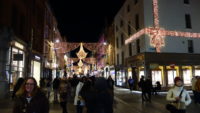 I was surprisingly efficient in finding and getting on a bus that was to take me back to Dublin. The trip was relatively quick, and because I carry a cell phone when I travel, I was able to text Shelby and found out they were at the museum. Based on that, I got off the bus a stop or two early and began following my phone directions to walk to the museum. I missed a turn that I was thinking of taking, but the phone dumped me out into Grafton Street, which is the shopping area for Dublin. It was all decked out in lights for Christmas. Mer and I have a CD with a song talking about how “on Grafton Street at Christmas time, the elbows push you round…,” so I texted Shelby a quick message on how “wow” Grafton Street was. She replied that they were on Grafton Street, outside a store called Pandora. I started to text back that I needed to look that up, as I would never find them in the masses of people, when Neuf walked up to me. I was standing directly outside the Pandora store, never having noticed it. That was happy.
I was surprisingly efficient in finding and getting on a bus that was to take me back to Dublin. The trip was relatively quick, and because I carry a cell phone when I travel, I was able to text Shelby and found out they were at the museum. Based on that, I got off the bus a stop or two early and began following my phone directions to walk to the museum. I missed a turn that I was thinking of taking, but the phone dumped me out into Grafton Street, which is the shopping area for Dublin. It was all decked out in lights for Christmas. Mer and I have a CD with a song talking about how “on Grafton Street at Christmas time, the elbows push you round…,” so I texted Shelby a quick message on how “wow” Grafton Street was. She replied that they were on Grafton Street, outside a store called Pandora. I started to text back that I needed to look that up, as I would never find them in the masses of people, when Neuf walked up to me. I was standing directly outside the Pandora store, never having noticed it. That was happy.
We went and found a restaurant and ate, and then went back to Grafton Street to take in the scene and window shop. We then went to find the statue of Molly Malone, who is a woman from a folk song about a woman who sells mussels and seafood. I had wanted to find the statue back in 2014, but they had moved her, so I missed it. When we were here last March, we ran out of time. This time, we all found her and had a good photo op.
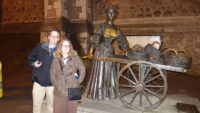 I wanted to see if a local pub had music on yet, so I went to look up where it was when the others pointed out we were looking at it. Another fine moment. Sadly, their music didn’t start until 9:30, and since it was only a little after 7:00 and we were all tired, we called it a night. We walked the twenty minutes or so back to the hotel.
I wanted to see if a local pub had music on yet, so I went to look up where it was when the others pointed out we were looking at it. Another fine moment. Sadly, their music didn’t start until 9:30, and since it was only a little after 7:00 and we were all tired, we called it a night. We walked the twenty minutes or so back to the hotel.
We had another fine day of touring in Ireland today, at least by my observation.
 Having a younger person (Shelby) on the trip is always a good thing. She was our taxi-summoner as needed, and she booked us in on our flight from her phone yesterday. In the past, I’ve always avoided doing that since airport bag check machines always told me to see a desk agent anyway. Today, it worked very well – we skipped the very long line for check-in, and so got to our gate in about thirty minutes. Which put us here three hours early.
Having a younger person (Shelby) on the trip is always a good thing. She was our taxi-summoner as needed, and she booked us in on our flight from her phone yesterday. In the past, I’ve always avoided doing that since airport bag check machines always told me to see a desk agent anyway. Today, it worked very well – we skipped the very long line for check-in, and so got to our gate in about thirty minutes. Which put us here three hours early. The food was quite good. I had heard that Dublin especially had gotten “foodie,” and we benefited. While we still had some good pub grub, we also had excellent American BBQ, good pizza, and yummy breakfasts, and in general ate too much.
The food was quite good. I had heard that Dublin especially had gotten “foodie,” and we benefited. While we still had some good pub grub, we also had excellent American BBQ, good pizza, and yummy breakfasts, and in general ate too much.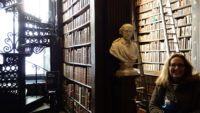 Despite our having been in Dublin multiple times, there are still some things I would wish to see. The little village of Howth is at the end of the Dublin DART train line, and is supposed to be cute. There is a replica famine ship on the Liffey. Mer and I have never done the Big Bus tour of the city, which is an overview of the sights of the city. We’ve never done the art museum, and Marsh’s Library of old books looks great.
Despite our having been in Dublin multiple times, there are still some things I would wish to see. The little village of Howth is at the end of the Dublin DART train line, and is supposed to be cute. There is a replica famine ship on the Liffey. Mer and I have never done the Big Bus tour of the city, which is an overview of the sights of the city. We’ve never done the art museum, and Marsh’s Library of old books looks great.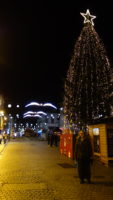 So, Lord willing, we’ll be back in Ohio tonight, which is always a bit mind-bending. I’m looking forward to my friends, family, kitties, and routine, of which I am fond. And I’m sure I’ll be used to work again in a few days.
So, Lord willing, we’ll be back in Ohio tonight, which is always a bit mind-bending. I’m looking forward to my friends, family, kitties, and routine, of which I am fond. And I’m sure I’ll be used to work again in a few days.
